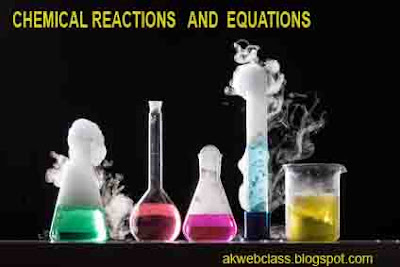In this article , we will discuss about chemical reaction , reactant, product. we also learn that what happend when chemical reaction is occurred . we will know about information giving chemical reaction.
- The processes in which new substances with new properties are formed is called Chemical reactions.
- During chemical reactions , a rearrangement of atoms takes place between the reacting substances to form new substances .
Example of a chemical reaction :
- Burning of magnesium ribbon, Burning of fuels, Formation of curd, Cooking of food, Digestion of food in our body, Process of respiration, Fermentation of grapes, Rusting of iron etc.
Reactants :
- The substances which take part in a chemical reaction to form new substances are called reactants .
Products:
- The new substances produced as a result of chemical reaction are called products .
Chemical reaction of ' magnesium with the ' oxygen ' of air :
- When a magnesium ribbon is heated , it burns in air with a dazzling white flame to form a white powder magnesium oxide .
- The magnesium ribbon usually has a coating of 'magnesium oxide' on its surface which is formed by the slow action of oxygen of air on it. So, before burning in air, the magnesium ribbon is cleaned by rubbing with a sand paper. This is done to remove the protective layer of magnesium oxide from the surface of magnesium ribbon so that it may readily combine with the oxygen of air (on heating).
Chemical equation:
- Representation of chemical reaction by symbolic formula of reactants and product is called chemical reaction.
For example:
- Zinc + sulphuric acid → Zinc sulphate + Hydrogen
- The above equation can be written in symbolic form which is known as chemical equation.
Zn + H2SO4 → ZnSO4 + H2
Information giving equation:
- The Chemical equation which gives more information about the chemical reaction is known as more informative or information giving equation.
- The chemical equations can be made more informative in three ways:
- By indicating the "physical states" of the reactants and products.
- By indicating the "heat changes" taking place in the reaction.
- By indicating the "conditions" under which the reaction takes place.
Indication of Physical states:
- There may be four physical states of the reactants and products in a chemical reaction: solid, liquid, aqueous solution and gas
- Solid state is indicated by the symbol (s)
- Liquid state is indicated by the symbol (l)
- Aqueous solution (solution made in water) is indicated by the symbol (aq)
- Gaseous state is indicated by the symbol (g)
Example:
- Ca(OH)2 ( aq) + CO2 (g) → CaCO3 (s) + H2O (l)
Characteristics of Chemical Reactions:
- The easily observable features (or changes) which take place as a result of chemical reactions are known as characteristics of chemical reactions. The important characteristics of chemical reactions are:
- Evolution of a gas
- Formation of a precipitate
- Change in colour
- Change in temperature
- Change in state
Evolution of a Gas:
- Some chemical reactions are characterized by the evolution of a gas.
Examples:
- Zn + H2SO4 → ZnSO4 + H2
- Na2CO3 + 2HCl → 2 NaCl + H2O + CO2
Formation of a Precipitate:
- Some chemical reactions are characterized by the formation of a precipitate.
For example,
- when potassium iodide solution is added to a solution of lead nitrate, then a yellow precipitate of lead iodide is formed.
- 2KI (aq) + PbNO3 (aq) → PbI2 (s) + 2 KNO3 (aq)
Change in Colour:
- Some chemical reactions are characterized by a change in colour.
For example,
- when citric acid reacts with potassium permanganate solution, then the purple color of potassium permanganate solution disappears (it becomes colorless).
Change in Temperature:
- Some chemical reactions are characterized by a change in temperature.
For example,
- When quicklime reacts with water, then slaked lime is formed and a lot of heat energy is produced. This heat raises the temperature due to which the reaction mixture becomes hot.
- 2CaO + 2H2O → 2Ca(OH)2 + Heat
Change in State:
- Some chemical reactions are characterized by a change in state.
For example,
- when wax is burned , carbon dioxide gas and water are formed.
- wax is a solid, water is a liquid whereas carbon dioxide is a gas. This means that during the combustion reaction of wax, the physical state changes from solid to liquid and gas.
- Thus, the combustion reaction of candle wax is characterized by a change in state from solid to liquid and gas.


No comments:
Post a Comment